How to Flip Domain Names

This article contains affiliate links that will allow us to earn commissions without any extra cost to you. Read our full disclosure here.
There’s a bit of controversy surrounding domain flipping, but this particular niche in ecommerce is definitely a popular business–a lucrative one, at that.
A domain is valued online real estate. It is, after all, the primary address associated with your brand or company. It’s also what users have to type on the browser.
If you’re thinking of dipping your toes into flipping domains, here are the fundamentals to get you started.
Listen to our podcast: E287: Landing on the Right Side When Flipping Domain Names
Contents
What Is Domain Flipping?
First of all, a domain is basically a web address. A URL. Top level domains, which are the most in demand and most common, are the .coms, .cos, .orgs, etc.
Simply put, it’s buy-and-sell… for domains. Flipping a domain means buying a domain with the intention of selling it. It’s exactly like flipping a house.

OR 10% OFF Every Month When You Use Code: ECOMCREW10
Flipping domains full-time is possible, but it will require a lot of patience and hard work, which is a given anyway if you want to succeed at what you do.
You can buy a domain for three digits and sell it for four or five digits. That’s how profitable this business is, as long you know how to play the game.
What Makes A Good Domain?
How do you know if a domain is worth flipping? Here’s a brief list of factors to consider when scouting for domains:
- Length. The general rule of thumb is that the shorter a domain is, the more valuable it is. Plus points if it's a common word or phrase that’s familiar and easy to remember.
- Newness. The key here is buying a fresh new domain before it becomes popular. This is why it’s important to research trends and identify potential in new domains.
- Searchability. In addition to being short and sweet, a domain that comes with words that have high search volume is a major green flag.
It’s also important to know that yes, there is value even in expired domains. In fact, the appeal of expired domains is in their history and how you can piggyback on their established authority.
How Do You Start Domain Flipping?
On the surface, it seems simple, right? Buy a domain for cheap and sell it with a significant markup. It sounds like a 1-2-3 kind of situation.
Here’s the thing: a higher payout sometimes entails higher risk, which is why it is important to approach the process carefully.
1. Look for a good domain.
By ‘good’, we mean one that’s affordable to purchase but with great potential to sell at a much higher value.
There are actually tools that you can use to search for domains that are up for purchase. Popular ones are GoDaddy, Spamzilla, Domain.com, Google Domains, and Namecheap.
Should the domain you’re looking for be available, you can purchase it through these websites as well.
2. Evaluate the domain.
Now, we proceed to quality check. Is the domain just the right length? Is it relevant? Is it easy to look up?
So many factors make a domain’s saleability such as SEO authority and traffic. It’s also important to compare prices before making the purchase.
You can preview prices through websites like Domain Compare and Domcomp to see which domain registrar offers the best deal for the domain you’re eyeing.
3. Register the domain.
Once you’ve found a hidden gem of a domain, it’s time you purchase it and register it under your ownership.
Purchasing a domain is a fairly simple process. You don’t really need any documents. It’s just like a regular online purchase, actually.
Depending on the domain, prices can range from $10 to $20/year, more or less. This still excludes registrar fees like hosting, security, and support.
Remember that owning a domain is not a one-off thing. If you want to keep it, you will have to pay an annual renewal fee.
4. Find the right buyer for the domain.
See, you don’t just give it to the first person who bids a good amount for it. You have to cull your potential buyers and see which one has the best offer.
If you have a wide network in ecommerce, one approach is to directly contact people who you think might be interested in the domain. This expedites the process significantly.
You don’t have to sell right away once an offer or two comes in. You can choose to wait it out and see if interest for the domain spikes over time.
5. Sell the domain.
You did it! Once you’ve found the lucky buyer, it’s time to make the sale official and turn over the domain.
There are some things you need to do before turning over the domain to the buyer.
- The domain privacy settings must be disabled.
- Double check if the admin email is updated.
- The domain has to be unlocked.
- Get a transfer authorization code.
- Have the new owner request a transfer.
- Once the request is made, you should receive an email notification. Simply approve the request and transfer shall begin!
How Is The Transaction Made?
To make sure a transaction of this nature goes smoothly and both parties are protected, it’s always best to process it through an escrow service to act as a mediator.
Like a broker, an escrow agent takes a percentage of the total amount, usually 5-10% – a commission basically.
Escrow.com, which is a great and straightforward domain name by the way, may be the obvious choice but there are other options like Vouch and Tazapay. Just make sure to be aware of the terms and conditions.
Final Thoughts
Flipping domains is not the traditional route most people in ecommerce take and there is certainly higher risk there due to the unpredictability of the market.
However, when done right and with a little bit of luck, you can earn a hefty sum from flipping domains, as a side hustle or even as a full-time gig.
Do you have experience flipping domains? Share your thoughts in the comments!







